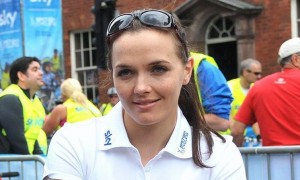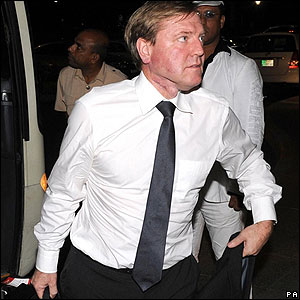
A gradual but inevitable descent into cricket-based loathing and bile.
Whatever Happened To The Unlikely Lads? #17: Hugh Morris
Looking back at the 1990s from the safe utopia of 2012, it seems that England’s team back then could have been better than they were, if only a settled policy of selection had been adopted. Of course, injuries took their tolls on players, which may or may not have been linked to playing too much, but consensus these days seems to be that if central contracts had been in place long before 2000, then England cricket would have been so much the better for it. Similarly, the National Academy has helped a conveyer belt of talented youngsters to meet their potential.
Nonetheless, there have been troughs even with central contracts and the academy (the words out, all and 51 spring to mind). Moreover, such was the general disarray of selection meetings in the 1990s, we daresay there’d nonetheless have been a lot of misfits awarded central contracts. Irrespective of whether there would have been better results and stronger performances, consistency of selection might have robbed us of many of our holy Unlikely Lads. In particular, for a period probably stretching as far back as Geoffrey Boycott’s retirement, the opening partnerships changed as regularly as Aussie Matt’s socks, i.e. about once a month. It is no surprise that England’s three most regular opening pairs have come from the central contract era (Cook & Strauss, Trescothick & Strauss and Trescothick & Vaughan). However Atherton and Gooch, for example, did not experience the same degree of selection consistency (their average opening partnership of 56.84 came from just 44 out of the 95 innings between the former’s debut and the latter’s retirement). Similarly, perhaps Atherton and Stewart, if given four years of opening together, could have provided the opening platform for Ramprakash and Hick to emulate the likes Mark Waugh down the order (or maybe not…not least because the Gaffer was often keeping wicket). What we do know for certain is that England used 20 different opening partnerships in the decade, with 15 different players, which begs the question: whatever happened to
#17: Hugh Morris
Chances are that, if you’re reading this website, you’ve either searched for Victoria Pendleton on Google Images, are a member of the Steve Smith fanclub (secretary: Larnach, M; treasurer: Larnach, M; chairman: Larnach, M.) or have a passing interest in cricket. Possibly all of the above. So you may actually know what happened to Hugh Morris, the current Managing Director of England Cricket.

We’re contractually obliged to post pictures of her.
His career had been consistent, if not particularly impressive, throughout the 1980s, including a three year spell captaining Glamorgan. But in 1990 he scored 2,276 runs and scored ten centuries (notwithstanding that it was a summer when everyone was making colossal scores for fun). With Atherton and Stewart’s careers still in their infancy, Gooch’s opening partner was far from an inked-in spot and Morris, a left-hander, was selected for a couple of games on the tour down under in 1990/91. In the first three Tests against the West Indies the following summer, Atherton failed to reach 50. The series was poised 1-1 (England had won the first match at Leeds due to Gooch’s amazing 154*) and Atherton was moved down the order in a reshuffle. Morris was the man chosen to open with the captain.

Morris the batsman.
In the 4th Test at Edgbaston, against a not bad attack comprising Marshall, Ambrose, Walsh and Patterson, Morris batted for a total of 16 minutes and faced 15 balls as he was dismissed twice for single figures. England were defeated by seven wickets and the sides headed to the Oval for what would turn out to be one of the great Test matches. In the first innings Morris battled for more than three hours, compiling 44 runs in a century stand with Gooch – arguably the platform on which England were able to invite their formidable opponents to follow-on. He only lasted five balls in the second innings, but with England securing a series draw with a five-wicket victory, things were looking up. The season ended with a solitary Test against Sri Lanka in which Morris again batted for a reasonable length of time but was dismissed for 42 and 23.
However, Morris wasn’t selected for the tour of New Zealand that followed, being handed the captaincy of the A team instead. By the summer, Stewart was the incumbent, and when he was moved down the order with the gloves, it was Atherton who was recalled. Morris never really had another sniff of a cap, despite selections for several other opening bats, although he did get the chance to captain another A tour. He kept performing for Glamorgan, making at least 1,200 runs each season – apart from 1994 – until his retirement in 1997, captaining the team to a Sunday League title along the way. Fittingly, in his last match in 1997, he scored 165 as Glamorgan beat Somerset to win their first Championship for a generation.

Morris the administrator.
Soon after retirement he was ECB technical director, then performance director and he helped set up the National Academy. In 2002 he survived throat cancer and a few years later in 2007, following the Schofield Report, he became Managing Director of England cricket; his tenure has seen a consistent approach to selection and general improvement on the field, but also the off-field troubles with Kevin Pietersen (still pending a satisfying conclusion and possibly tarnishing Morris’s reputation) and the far more important dilemmas in the aftermath of the Mumbai terrorist attacks. It is fitting therefore, that a man who benefited from the inconsistent selections of the early 1990s has been fundamental to the shifts towards the modern, largely successful era. With his MBA and skills in leadership and diplomacy, Morris may have been an unlikely lad, but he was always going to be a likely man.

No Comments
Post a Comment